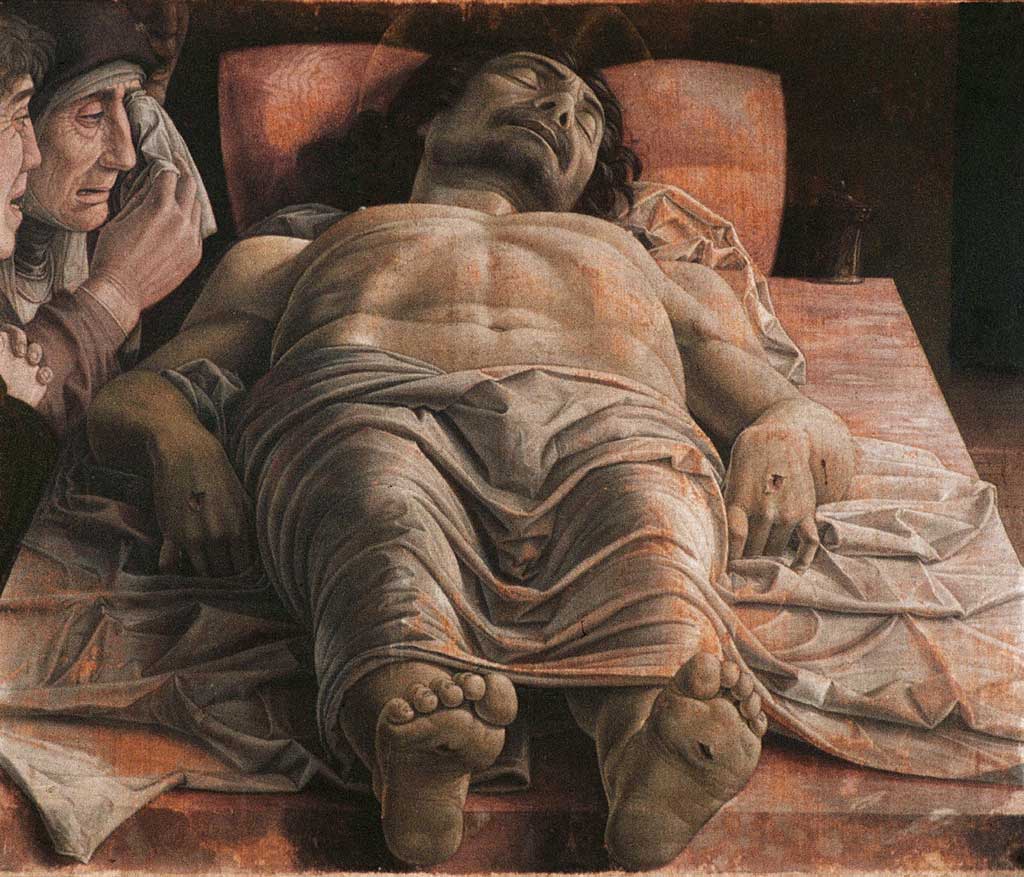Great Works: The Dead Christ, by Andrea Mantegna c.1480
Pinacoteca di Brera, Milan

We are wholly accustomed to contemplating the person of Jesus in his death-wracked agony on the Cross. We see how the body is both stretched in its suspension, pulled earthwards by its own weight like so much skewered meat, and often skewed to the side, painfully and unnaturally. And yet, generally speaking, there is usually a degree of compassion in the painter's gaze, and an unspoken agreement between patron and artist that the whole must tend towards the heroic and the noble. After all, the entire world must be persuaded to agree that this man is more than a mere man amongst mere men.
By comparison, this daringly experimental view by Mantegna takes us aback. It seems to incline towards ugliness or, at the very least, a cool impartiality that almost borders upon irreverence. Its presence here feels so sudden, so jarring, so quickly upon us when we catch sight of it. It looks like a corpse on a mortuary trolley that has been slammed into our knees, a partially exposed corpse, feet-first. Except that this is a marble slab on which the body lies.
It puts us in mind somewhat of a great drawing by Mantegna that may have been a preparatory sketch for this painting. That was called Man Lying on a Stone Slab, and it was exhibited most recently in England in the spring of 2010 as part of the great show of Italian Renaissance Drawings at the British Museum. There the figure lying supine on a slab was, though semi-comatose, undeniably alive, and even rising up on its elbows.
Not so here. Here there is nothing but the oppressive stench of some charnel house ripped straight out of the pages of a novel by Emile Zola. The space here feels strangely small, pent, confined, fuggy with death, ghastly, ghoulish, tomb-like. The presences of Mary, John (that most favoured disciple) and Mary Magdalene (the identification of this third human presence, the one furthest away from us, is little better than guesswork because we get little more than a semi-occluded view of the lower face), are almost too close to the cadaver for comfort, squeezed up against the body, mouths agape, as if in horrified and near incredulous fascination. The limited range of colours Mantegna is using here – these pinks, greys, dusty blues – both add weight to the general atmosphere of dolour, and seem to draw the space in.
The face of Mary – see how she and John spill tears, she much more extravagantly as she tamps at her eye – looks mask-like and almost haggard with grief. The angle of view is so low (was Mantegna intending that we should look at this painting from below?) that the body seems curiously, almost grotesquely, foreshortened; this looks like the body of a dead dwarf, with a large and over-heavy head.
The ribcage, faintly marked with almost decorative lacerations, looks oddly swelled as if pumped until it is on the brink of manly posturing. The wounds on hands and feet are curious too, open and dry. The flesh looks cracked and dusty. We are not accustomed to having the soles of Christ's feet thrust out towards us in this way – as if feet were more important in the emotional scale of things than the face or the hands. The body is that of a relatively heavy man of some musculature. That is unusual too. Representations of Christ most often swing between the handsomely homoerotically able-bodied and the ascetic. Much more unusual would be the plump Saviour. Or is this dramatic use of foreshortening playing tricks with us?
The body, with its horribly pallid, lolling head, looks thoroughly, quite humdrumly, dead – a dead weight you could say – as if this were any man's death, anywhere. It feels entirely robbed of its aura of sanctity, saintliness, special otherness. It does not seem to promise that it will rise again to speak of the coming kingdom to its amazed and adoring proselytes, or, in due course, to set about harrying Hell or undertaking other serious, posthumous duties. In fact, in mood, it puts us in mind of Ron Mueck's Dead Dad. It's thoroughly gone, never to return. The rucking of the fabric is quite magnificent too, flowing down onto that slab in keenly etched rivulets.
Ecce homo indeedy.
About the artist: Andrea Mantegna (c.1431 – September 13, 1506)
Andrea Mantegna was one of the master painters and engravers of the northern Italian Renaissance. A number of his great early Paduan frescos were destroyed during the Second World War. Some of his greatest works are to be seen in Mantua, where he served as court painter to the Gonzaga family, and illustrated incidents in the lives of his patrons. His ceiling of the Camera degli Sposi is a triumph of illusionistic perspective.
Join our commenting forum
Join thought-provoking conversations, follow other Independent readers and see their replies
Comments
Bookmark popover
Removed from bookmarks